
Neva Enfilade of the Winter Palace
Encyclopedia
.jpg)
Winter Palace
The Winter Palace in Saint Petersburg, Russia, was, from 1732 to 1917, the official residence of the Russian monarchs. Situated between the Palace Embankment and the Palace Square, adjacent to the site of Peter the Great's original Winter Palace, the present and fourth Winter Palace was built and...
, St Petersburg is a series of three large halls arranged in an enfilade
Enfilade (architecture)
In architecture, an enfilade is a suite of rooms formally aligned with each other. This was a common feature in grand European architecture from the Baroque period onwards, although there are earlier examples, such as the Vatican stanze...
along the palace's massive facade facing the River Neva.
Originally designed as a series of five state rooms by the architect Francesco Rastrelli
Francesco Bartolomeo Rastrelli
Francesco Bartolomeo Rastrelli was an Italian architect naturalized Russian. He developed an easily recognizable style of Late Baroque, both sumptuous and majestic...
in 1753, they were transformed into an enfilade of three vast halls in 1790 by Giacomo Quarenghi
Giacomo Quarenghi
Giacomo Quarenghi was the foremost and most prolific practitioner of Palladian architecture in Imperial Russia, particularly in Saint Petersburg.- Career in Italy :...
. Following a fire in 1837 they were rebuilt under the direction of Vasily Stasov
Vasily Stasov
Vasily Petrovich Stasov was a Russian architect.-Biography:Stasov was born in Moscow....
. Frequently used as the palace ballrooms, they formed a processional route, and were the focus of the imperial court. In 1915, the last Tsar, Nicholas II
Nicholas II of Russia
Nicholas II was the last Emperor of Russia, Grand Prince of Finland, and titular King of Poland. His official short title was Nicholas II, Emperor and Autocrat of All the Russias and he is known as Saint Nicholas the Passion-Bearer by the Russian Orthodox Church.Nicholas II ruled from 1894 until...
had the enfilade transformed into a military hospital
Military hospital
Military hospital is a hospital, which is generally located on a military base and is reserved for the use of military personnel, their dependents or other authorized users....
. Following the Russian Revolution of 1917, the enfilade, along with the remainder of the building, has been used as a series of exhibition halls of the State Hermitage Museum.
History
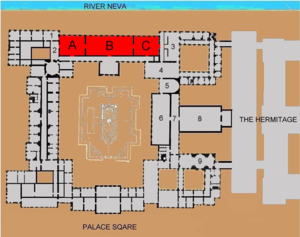
Fyodor Matveyevich Apraksin
Count Fyodor Matveyevich Apraksin was one of the first Russian admirals who governed Estonia and Karelia from 1712 to 1723, general admiral , presided over the Russian Admiralty since 1718 and commanded the Baltic Fleet since 1723.-Early shipbuilding activities:The Apraksin brothers were...
, this she had rebuilt to form her own Winter Palace.
During the reign of Anna's successor, Elizabeth, Rastrelli, still working to his original plan, devised an entirely new scheme in 1753, on a colossal scale—the present Baroque
Baroque
The Baroque is a period and the style that used exaggerated motion and clear, easily interpreted detail to produce drama, tension, exuberance, and grandeur in sculpture, painting, literature, dance, and music...
Winter Palace (externally the palace seen today); the Tsaritsa wanted the palace to exceed in beauty and size all other European royal palaces. The expedited completion of the palace became a matter of national honour to the Empress, and to pay for it taxes were increased on salt and alcohol to fund the extra costs, although the Russian people were already burdened by taxes to pay for Russia's wars. The final cost was 2,500,000 rubles. By 1759, shortly before Elizabeth's death, an imperial Palace truly worthy of the name was nearing completion; at that time, the Neva enfilade contained five the principal state rooms. Work continued during the short reign of Elizabeth's nephew Peter III and on into the reign of Peter's widow Catherine the Great.
During Catherine the Great's reign, Neoclassicism came into vogue, and the new Tsaritsa was a great admirer. Rastrelli was dismissed and new architects working in the new fashions were employed. During this period, the original ornate rococo decoration of the palace was replaced with the more simple and stark neoclassicism which is a hallmark of the Palace today. The Neva enfilade was completely redesigned between 1790-93 by the architect Giacomo Quarenghi
Giacomo Quarenghi
Giacomo Quarenghi was the foremost and most prolific practitioner of Palladian architecture in Imperial Russia, particularly in Saint Petersburg.- Career in Italy :...
. Taking in the floor above, he transformed the original five rooms into three vast halls: the Concert Hall, the Great Hall and the Great Ante-Room. They were decorated in classical style with faux marbre and columns supporting life size statues.
Following a disastrous fire which destroyed most of the Winter Palace's interiors in 1837, the halls were recreated in similar style by the architect Vasily Stasov
Vasily Stasov
Vasily Petrovich Stasov was a Russian architect.-Biography:Stasov was born in Moscow....
.
Court use of the enfilade
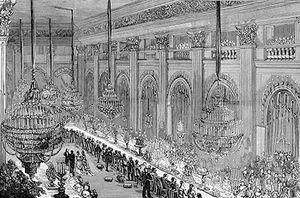
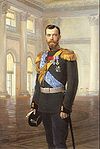

Piano nobile
The piano nobile is the principal floor of a large house, usually built in one of the styles of classical renaissance architecture...
would be in near constant use. The remainder of the year the imperial couple resided elsewhere, and the palace housed the staff and the officials of the monarchy, who occupied the ground and second floors. The halls of the enfilade were designed to form an important part in the ceremonial life of the court, not just as ballrooms for festivities but for processional use. From the entrance to the private apartments at the western end of the Concert Hall, Imperial processions would proceed in state through the enfilade to the Jordan Staircase
Jordan Staircase of the Winter Palace
The principal or Jordan Staircase of the Winter Palace, St Petersburg is so called because on the Feast of the Epiphany the Tsar descended this imperial staircase in state for the ceremony of the "Blessing of the Waters" of the Neva River, a celebration of Christ's baptism in the Jordan River. The...
or turn and continue through the eastern state rooms.
Before 1917, during ceremonies and functions, access to the various hall of the enfilade was dictated by rank. Those who were most important were positioned closest to the beginning of an imperial procession in the Concert Hall, the lesser exalted in the Nicholas Hall and the least important in the Great Ante-Room. The imperial court was very conscious of rank. This was particularly obvious amongst the ladies attached to the court. Etiquette dictated that all these ladies, regardless of age, wore white silk dresses with a low decolletage
Décolletage
Décolletage is the upper part of a woman's torso, between her waist and neck, comprising her neck, shoulders, back and chest, that is exposed by the style of her clothing. However, the term is most commonly applied to a neckline which reveals or emphasizes cleavage...
and a red or olive green velvet train with gold embroidery. On their heads they wore red or green kokoshnik
Kokoshnik
The kokoshnik is a traditional Russian head-dress worn by women and girls to accompany the sarafan. It is patterned to match the style of the sarafan and can be pointed or round. It is tied at the back of the head with long thick ribbons in a large bow. The forehead is sometimes decorated with...
s studded with jewels. While other women present were allowed coloured dresses, the train and kokoshnik was mandatory court dress.
Further classification was given to the women's ranks by indication of whether they were "Dames a Portrait" or "Demoiselles d'Honneur." The former, higher ranking class wore the Tsaritsa's portrait mounted in diamonds on their left breast, while the latter wore the Tsaritsa's monogram surrounded by diamonds. In between these two ranks were the "Dames du Palais" who like the "Dames a portrait" wore olive green, the lower ranking "Demoiselles d'Honneur" wore red.
While red and green were the colours of the Tsar and Tsaritsa, further colour was added by the women attached to the numerous Grand Duchesses. Each Grand Duchess had her own colour, and all the ladies attached to the suite would wear it. Queen Victoria's foreign secretary, writing to her in 1894 of a state procession through the enfilade, recorded of the Grand Duchesses' colours that one "is a particularly hideous shade of orange." The Foreign Secretary then went on to describe the "8,000 to 10,000" people present in the Winter palace's "interminable halls", and a particular "Demoiselle d'Honneur" who was "so old that she was propped up against a wall." Overall, the splendour and size of the Winter Palace and its colourful and bejewelled ladies failed to impress the Foreign Secretary for he reported to the Queen that the Grand Church "was not very large" and that the assembled imperial court had "an absence of beauty as compared with that seen at one of Your Majesty's drawing rooms." He did, however, concede that the Queen's granddaughter looked "simply magnificent...the perfection of what one would imagine an Empress of Russia on her way to the altar would be.". That wedding of Queen Victoria's granddaughter to the Tsar was to be one of the final huge gatherings at the Palace, however. The palace's state rooms had had their swan song
Swan song
"Swan song" is a metaphorical phrase for a final gesture, effort, or performance given just before death or retirement. The phrase refers to an ancient belief that the Mute Swan is completely silent during its lifetime until the moment just before death, when it sings one beautiful song...
during the reign of Alexander II
Alexander II of Russia
Alexander II , also known as Alexander the Liberator was the Emperor of the Russian Empire from 3 March 1855 until his assassination in 1881...
between 1855 and 1881.
Alexander II was the last Tsar to use the Winter Palace extensively not only for governing the empire but also entertaining. Of special note were the Bals des Palmiers given at the palace. On these occasions, 100 palm trees were brought from the hot houses at Tsarskoe Selo; these would be scattered throughout the enfilade, and around them supper tables seating 15 people would be constructed. During the course of the evening the Tsar would make the rounds of the tables, eating a piece of bread or fruit at each, in order that the guests may say that they had dined with the Tsar.
Following the assassination of Alexander II, the Winter Palace was never truly inhabited again. The new Tsar Alexander III
Alexander III of Russia
Alexander Alexandrovich Romanov , historically remembered as Alexander III or Alexander the Peacemaker reigned as Emperor of Russia from until his death on .-Disposition:...
was informed by his security advisers that it was impossible to make the Winter Palace secure. The Imperial family then moved to the seclusion of the Palace of Gatchina, some 40 miles from St. Petersburg. When in St. Petersburg, the Imperial family resided at the Anichkov Palace
Anichkov Palace
Anichkov Palace is a former imperial palace in Saint Petersburg, at the intersection of Nevsky Avenue and the Fontanka.-History:The palace, situated on the plot formerly owned by Antonio de Vieira, takes its name from the nearby Anichkov Bridge across the Fontanka...
, but the Winter Palace was used for official functions. Alexander III, however, was not a lover of society and, when using the Winter Palace, preferred playing bridge in an anteroom to dancing. While most St Petersburg balls did not conclude until 6am, at the Winter Palace, from 2am the Tsar would dismiss the musicians from the orchestra one by one, until only the pianist and a fiddler remained, by which time his guests had taken the hint and gone.
The final imperial reception at the Winter Palace was a themed, fancy dress ball celebrating the reign of Alexei I
Alexis I of Russia
Aleksey Mikhailovich Romanov was the Tsar of Russia during some of the most eventful decades of the mid-17th century...
, which took place on 22 January 1903. The Grand Duke Alexander Mikhailovitch
Grand Duke Alexander Mikhailovich of Russia
Grand Duke Alexander Mihailovich of Russia, Александр Михайлович Aleksandr Mihailovits was a dynast of the Russian Empire, a naval officer, an author, explorer, the brother-in-law of Emperor Nicholas II, and an advisor of the said Emperor.-Biography: Alexander was born the son of Grand Duke...
recalled the occasion as "the last spectacular ball in the history of the empire...[but] a new and hostile Russia glared through the large windows of the palace...while we danced, the workers were striking and the clouds in the Far East were hanging dangerously low." The entire Imperial family, the Tsar as Alexei I and the Tsaritsa as Maria Miloslavskaya
Maria Miloslavskaya
Maria Ilyinichna Miloslavskaya was the first wife of tsar Alexis of Russia and mother of the tsars Feodor III of Russia and Ivan V of Russia, as well as regent princess Sophia Alekseyevna.-Biography:...
, all dressed in rich 17th century attire posed in the Hermitage's theatre, many wearing priceless original items brought specially from the Kremlin
Kremlin
A kremlin , same root as in kremen is a major fortified central complex found in historic Russian cities. This word is often used to refer to the best-known one, the Moscow Kremlin, or metonymically to the government that is based there...
, for what was to be their final photograph together. The following year Russia was at war, and the Tsar and Tsaritsa abandoned St Petersburg, the Winter Palace, and high society (considered by the Tsaritsa to be decadent and immoral ) for the greater comfort, security and privacy of Tsarskoe Selo.
The Concert Hall
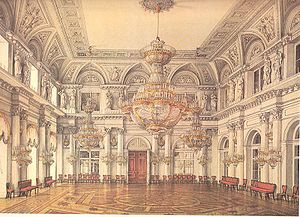
Architrave
An architrave is the lintel or beam that rests on the capitals of the columns. It is an architectural element in Classical architecture.-Classical architecture:...
seemingly supported by paired Corinthian columns, the capitals of which serve as plinthes for life-size statues of the various muse
Muse
The Muses in Greek mythology, poetry, and literature, are the goddesses who inspire the creation of literature and the arts. They were considered the source of the knowledge, related orally for centuries in the ancient culture, that was contained in poetic lyrics and myths...
s. It is decorated in a similar loose Baroque influenced neoclassical style as the Great Anteroom at the western end of the Enfilade. It is indicative of the size of the Winter Palace, that whereas most other royal palaces such as Buckingham Palace
Buckingham Palace
Buckingham Palace, in London, is the principal residence and office of the British monarch. Located in the City of Westminster, the palace is a setting for state occasions and royal hospitality...
, Queluz
Queluz National Palace
The Queluz National Palace is a Portuguese 18th-century palace located at Queluz, a freguesia of the modern-day Sintra Municipality, in the Lisbon District. One of the last great Rococo buildings to be designed in Europe, the palace was conceived as a summer retreat for Dom Pedro of Braganza,...
and Sanssouci
Sanssouci
Sanssouci is the name of the former summer palace of Frederick the Great, King of Prussia, in Potsdam, near Berlin. It is often counted among the German rivals of Versailles. While Sanssouci is in the more intimate Rococo style and is far smaller than its French Baroque counterpart, it too is...
all have music rooms, the Winter Palace has a concert hall this is because it was the intention of the builders of the Winter Palace that their palace should outshine all other royal palaces. In fact Catherine the Great, for whom the enfilade was designed, was delighted when she bought an art collection for the Winter palace that Frederick the Great, the creator of Sanssouci could not afford.
So it was, that from this vast double height hall that solemn Imperial processions began. On such occasions the Concert Hall would be reserved for the highest ranking guest and members of the court. At a given moment, four "massive Ethiopians", the Tsar's official bodyguards, fantastically dressed in scarlet trousers, gold jackets, white turbans and curved shoes, would ceremonially open the doors from the private Arabian Hall
Arabian Hall of the Winter Palace
The Arabian Hall, sometimes known as the Blackamoor Hall or the Arabian Dining Room, is one of the semi-private rooms of the Winter Palace in Saint Petersburg. In the Tsarist era, it was the room from which imperial processions through the state rooms began...
(2 on plan above) and the imperial procession would pass through the enfilade. The procession through would be preceded by the Marshal of the Court carrying a gold staff seven feet high topped with a diamond crown. On less formal occasions, as the hall's name name suggests, it was used for concerts, balls and grand receptions.
Today, as part of the State Hermitage Museum, the room houses the silver reliquary of St Alexander Nevsky, formerly at the Alexander Nevsky Monastery. The reliquary was brought to the Palace in 1922, where it was set up to obscure the now blocked, grand doors from which the Imperial family used to enter from the private apartments.
The Nicholas Hall
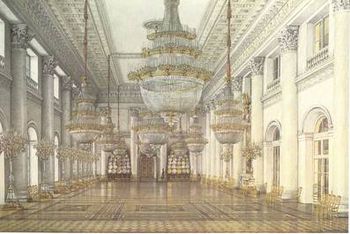
Nicholas I of Russia
Nicholas I , was the Emperor of Russia from 1825 until 1855, known as one of the most reactionary of the Russian monarchs. On the eve of his death, the Russian Empire reached its historical zenith spanning over 20 million square kilometers...
in 1855, a large equestrian portrait of the late tsar was hung from the wall, and the hall was renamed the Nicholas Hall.
While in the same architectural rhythm as the preceding Concert Hall, the architecture is more severe. Here, the architrave is immediately below the ceiling. The only ornamentation is the carving of the corinthian capitals and the entablature
Entablature
An entablature refers to the superstructure of moldings and bands which lie horizontally above columns, resting on their capitals. Entablatures are major elements of classical architecture, and are commonly divided into the architrave , the frieze ,...
.
Writing in 1902, the Duchess of Sutherland
Millicent Sutherland-Leveson-Gower, Duchess of Sutherland
Millicent Sutherland-Leveson-Gower, The Duchess of Sutherland was a British society hostess, social reformer, author, editor, journalist, and playwright, often using the pen name Erskine Gower. Her first husband was Cromartie Sutherland-Leveson-Gower, 4th Duke of Sutherland...
and the American-born Duchess of Marlborough
Consuelo Vanderbilt
Consuelo Balsan , was a member of the prominent American Vanderbilt family...
, herself the chatelaine of one of Britain's great palaces
Blenheim Palace
Blenheim Palace is a monumental country house situated in Woodstock, Oxfordshire, England, residence of the dukes of Marlborough. It is the only non-royal non-episcopal country house in England to hold the title of palace. The palace, one of England's largest houses, was built between...
, described their impressions of a court ball held in the Nicholas Hall.
-
- The Duchess of Sutherland wrote: "The stairs of the palace were guarded by cossackCossackCossacks are a group of predominantly East Slavic people who originally were members of democratic, semi-military communities in what is today Ukraine and Southern Russia inhabiting sparsely populated areas and islands in the lower Dnieper and Don basins and who played an important role in the...
s, with hundreds of footmenFootmanA footman is a male servant, notably as domestic staff.-Word history:The name derives from the attendants who ran beside or behind the carriages of aristocrats, many of whom were chosen for their physical attributes. They ran alongside the coach to make sure it was not overturned by such obstacles...
in scarlet liveriesLiveryA livery is a uniform, insignia or symbol adorning, in a non-military context, a person, an object or a vehicle that denotes a relationship between the wearer of the livery and an individual or corporate body. Often, elements of the heraldry relating to the individual or corporate body feature in...
, I have never in my life seen so brilliant a sight - the light, the uniforms, the enormous rooms, the crowd, the music, making a spectacle that was almost Barbaric in splendour...They seat at supper nearly four thousand people"
- The Duchess of Sutherland wrote: "The stairs of the palace were guarded by cossack
-
- While the Duchess of Marlborough recorded that dinner (she sat beside the Tsar) was protracted and comprised "soups, caviar and monster sturgeons, meat and game, pates and primeurs, ices and fruits, all mounted on gold and silver plate fashioned by GermainFrançois-Thomas GermainFrançois-Thomas Germain , the son of Thomas Germain, was a French silversmith who was often commissioned by royalty. In 1765 Germain broke guild regulations by working with financiers to receive some debts owed to him, as he was only allowed to enter into partnerships with his fellow smiths. For...
"
- While the Duchess of Marlborough recorded that dinner (she sat beside the Tsar) was protracted and comprised "soups, caviar and monster sturgeons, meat and game, pates and primeurs, ices and fruits, all mounted on gold and silver plate fashioned by Germain
Ironically, the Duchess of Sutherland then went on to describe the hungry peasants outside the gates - "... all the want of penury of the peasants and this strange show to keep up the prestige of the aristocracy and the autocracy of one gentle, quiet little man."
During World War I
World War I
World War I , which was predominantly called the World War or the Great War from its occurrence until 1939, and the First World War or World War I thereafter, was a major war centred in Europe that began on 28 July 1914 and lasted until 11 November 1918...
, the hall was used as an infirmary. It was restored in 1957, when the State Hermitage Museum was under the direction of Mikhail Artamonov
Mikhail Artamonov
Mikhail Illarionovich Artamonov Artamonov's scientific career was centered on the Leningrad University, where he was a professor since 1935 and the head of the chair of archeology since 1949. He researched Bronze Age and Iron Age settlements by the Don River, in the North Caucasus and in the Ukraine...
.
The Great Antechamber
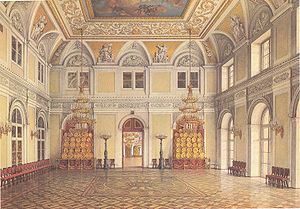
Winter Palace
The Winter Palace in Saint Petersburg, Russia, was, from 1732 to 1917, the official residence of the Russian monarchs. Situated between the Palace Embankment and the Palace Square, adjacent to the site of Peter the Great's original Winter Palace, the present and fourth Winter Palace was built and...
is the principal entrance hall to the state apartments of the palace. The first room of the piano nobile
Piano nobile
The piano nobile is the principal floor of a large house, usually built in one of the styles of classical renaissance architecture...
at the head of the Jordan staircase
Jordan Staircase of the Winter Palace
The principal or Jordan Staircase of the Winter Palace, St Petersburg is so called because on the Feast of the Epiphany the Tsar descended this imperial staircase in state for the ceremony of the "Blessing of the Waters" of the Neva River, a celebration of Christ's baptism in the Jordan River. The...
, it formed the processional exit of the Neva enfilade, and presented a procession with a choice, either to descend the staircase and exit the palace, which happened once a year for the ceremony of blessing the waters of the Neva, or to turn right and continue through the next enfilade to the small throne room
Small Throne Room of the Winter Palace
The Small Throne Room of the Winter Palace, St Petersburg, also known as the Peter the Great Memorial Hall, was created for Tsar Nicholas I in 1833, by the architect Auguste de Montferrand...
(5) or continue on through the Armorial Hall
Armorial Hall of the Winter Palace
The Armorial Hall of the Winter Palace is a vast chamber originally designed for official ceremonies. The Armorial Hall is located between the Military Gallery and the palace courtyard....
(6) and Military Gallery (7) to the Great Throne Room (8) or Grand Church
Grand Church of the Winter Palace
The Grand Church of the Winter Palace in Saint Petersburg, sometimes referred to as the Winter Palace's cathedral, was consecrated in 1763. It is located on the piano nobile in the eastern wing of the Winter Palace, and is the larger, and principal, of two churches within the Palace...
(9).
Exhibition Halls
Today, as part of the State Hermitage Museum the halls of the Neva enfilade are preserved as "palace interiors" containing only minimal furniture they are used for exhibitions. Many of the mirrors which lined the interior walls opposite each window have been concealed behind exhibition boards which creates a utilitarian feel to the halls, and one has to look upwards to the carved captalCaptal
Captal , was a medieval feudal title in Gascony. According to Du Cange the designation captal was applied loosely to the more illustrious nobles of Aquitaine, counts, viscounts, etc., probably as capitales domini, principal lords, though he quotes more fanciful explanations.As an actual title the...
s, statues, great chandeliers and moulded ceilings to gain an impression of the hall's glacial grandeur and classical architecture.

